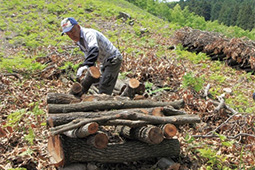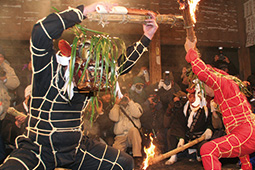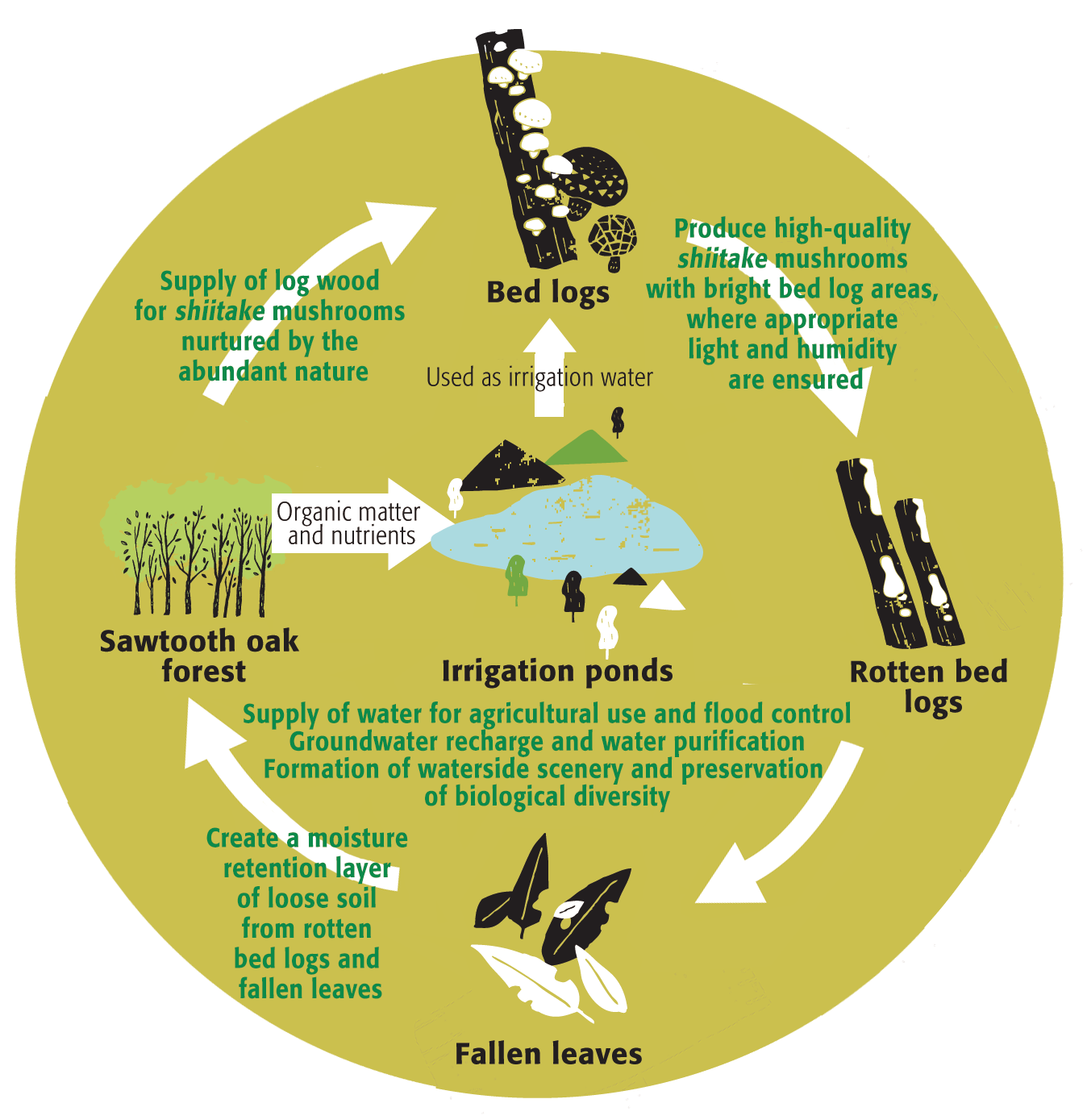INDEX

After two summers, the logs with well-established shiitake mushroom fungi are moved to a location suitable for the development of shiitake mushrooms 
Planting seed pieces containing shiitake mushroom mycelium in drilled log wood 
The planted logs are laid down on the mountainside in covered to provide shade so that the shiitake mushroom mycelium can grow well in the logs. 
Shujo Onie, an Important Intangible Folk Cultural Property, is closely tied to agriculture
- PREVIOUS
- NEXT
June 2021
The Log Wood Cultivated Shiitake Mushrooms of the Kunisaki Peninsula and Usa Region

In the Kunisaki Peninsula and Usa region in Oita Prefecture, shiitake mushrooms (Lentinula edodes) continue to be cultivated in a traditional agricultural system using kunugi (sawtooth oak, Quercus acutissima). The interlinked system of sawtooth oak trees and multiple irrigation ponds supports a variety of agriculture, forestry and fishery industries including the country’s sole production area of shichitoui (a kind of grass [Cyperaceae] used to make tatami mats) while preserving the diverse ecosystem. “Agriculture, Forestry and Fisheries Circulation in Usa, Kunisaki Peninsula, where Kunugi Forest and Reservoir Connect” was recognized as a Globally Important Agricultural Heritage System in May of 2013.

The Kunisaki Peninsula and Usa region is made up of four cities, a village and a town and stretches across the Kunisaki Peninsula in northeastern Oita Prefecture. With only a small area of plains, most of the peninsula is mountainous, made up of deep valleys and mountain ridges that stretch radially from the range of mountain peaks centered on Mt. Futago, a 721-meter-tall mountain almost right in the middle of the peninsula. That’s why, since long ago, forest resources have sustained the people of the region, and the cultivation of shiitake mushrooms utilizing these forest resources has flourished.
Hayashi Hiroaki, chairman of the Kunisaki Peninsula Usa GIAHS Promotion Association, whose family has been involved in the production of shiitake mushrooms for generations, says that “Oita Prefecture boasts the largest amount (volume of tree trunks) of sawtooth oak trees in all of Japan, and this wood is perfect for the wood ‘bed logs’ that nurture the seed fungus used when cultivating shiitake mushrooms. As the bark is thick, only healthy, strong fungi can break through the bark and produce mushrooms. The shiitake mushrooms cultivated here are fleshy and highly aromatic with a good flavor.”

To acquire the bed logs essential for mushroom cultivation, people here carefully grow the sawtooth oak trees that will become log wood. Sawtooth oak sown with the fungus of shiitake mushrooms can be used as a bed log for three to four years, and once the logs have been used, the wood is returned to the mountain to become soft, mineral-rich soil, forming a moisture-retaining layer. This allows the forest to renew itself, while people here work together and never fail to maintain and protect the sawtooth oak forests.
Shiitake mushroom cultivation requires moderate shade, airflow, humidity and water, but the region is one of the least rainy regions of Japan. Consequently, many irrigation ponds have been built in the region since long ago, and today, there are more than 1,200 such ponds. Unable to create large ponds due to the mountainous terrain, multiple small-scale ponds were ingeniously connected, ensuring the necessary amount of water for shiitake mushroom cultivation and other agriculture. In one area, there is an irrigation pond known as Misakoike, and here, a caretaker, known as an ikemori (pond protector), is still chosen today, and this person keeps an eye on the pond to ensure the timely distribution of the appropriate amount of water wherever it is needed in the region.


Hayashi says that the people in this area have been strongly bonded through water for generations and have relationships of mutual cooperation.
He also says that there are many temples of the Tendai sect of Buddhism in the area, while another characteristic of the area is the many festivals related to agriculture that still remain today, including the Shujo Onie, which has been designated an Important Intangible Folk Cultural Property.
It has been eight years since the region was designated a Globally Important Agricultural Heritage System in May 2013. On the results of this designation, Hayashi says, “forestry, agriculture, and fishery industries passed down through generations have been globally recognized, while learning about and experiencing these industries gives children pride in their region, I feel.”

Ajimu Town, the birthplace of agritourism* in Japan, is found here in Usa City. There is a desire here to improve tourist experiences such as log wood shiitake mushroom cultivation, rice growing, and other agricultural and traditional craft experiences.
Centered on the Kunisaki Peninsula and Usa region, Oita Prefecture’s output of dried shiitake mushrooms produced through log wood cultivation is the highest in Japan, accounting for 43% of domestic production. Shiitake rice, made by steaming rice and water-rehydrated dried shiitake mushrooms together, is one of the region’s local delicacies. The firmness of the plump shiitake mushrooms, the abundant forests that produce their fragrance, and the many ponds built and protected by the people here are all part of the allure of the Kunisaki Peninsula and Usa region.
* It is called “green tourism” in Japan.

- PREVIOUS
- NEXT

